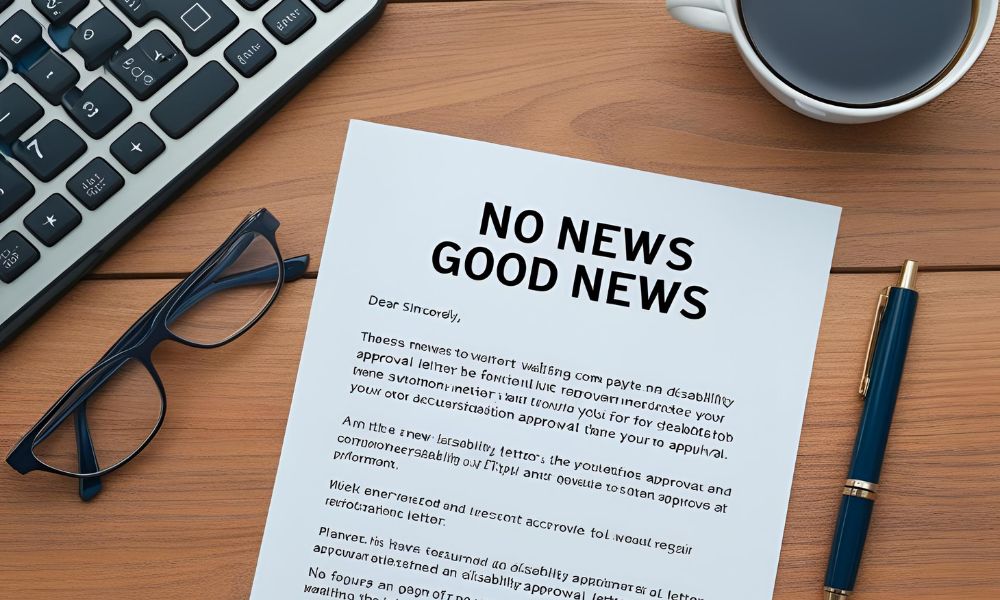You’re waiting on a disability approval letter, and the silence from the Social Security Administration can feel deafening. Is it a sign that your application is still being reviewed, or does it hint at something more concerning? While no news might seem like a positive sign, it can also lead to uncertainty and anxiety. Understanding the nuances of this waiting game is crucial, and there are specific steps you can take to gain clarity on your situation. What should you do next to ensure your application remains on track?
Understanding the Approval Process
When you’re waiting for a disability approval letter, it’s crucial to understand the approval process to manage your expectations. This process involves several steps, and knowing what to expect can ease your anxiety.
First, your application is reviewed for completeness. If anything’s missing, the Social Security Administration (SSA) may delay your approval.
Next, medical evidence plays a significant role. The SSA evaluates your medical records, doctor’s notes, and any additional information you submit to determine if your condition meets their criteria. You have to be thorough in providing all relevant documentation to support your claim.
It’s also important to remember that claims can be denied for various reasons, such as insufficient medical evidence or failure to follow treatment recommendations.
Once the review is complete, you’ll either receive an approval or a denial letter. If you’re denied, you can appeal, which involves another review process.
Understanding these steps helps you realize that waiting is part of the journey. It’s essential to stay proactive, follow up on your claim, and keep records organized to ensure you’re prepared for any outcome.
The Timeline of Disability Claims
Understanding the approval process helps set realistic expectations, but it’s also important to grasp the timeline of disability claims. The journey often begins when you submit your application, which can take anywhere from a few weeks to several months to process.
After submission, the Social Security Administration (SSA) typically takes three to five months to make an initial decision.
If your claim is denied, you can appeal, which adds additional time. The appeals process can take several months to a couple of years, depending on the backlog at your local office. Each stage of the appeal—reconsideration, hearing, and appeals council—can further extend the timeline.
Once you receive approval, it may take additional weeks for your benefits to start, as the SSA needs to calculate your back pay and ensure your information is accurate.
Throughout this process, communication is key. You should check your claim status regularly and respond promptly to any requests for information. By understanding this timeline, you can better prepare for the wait and manage your expectations during a challenging time.
Common Reasons for Delays
Several factors can contribute to delays in receiving your disability approval letter. One common reason is incomplete medical records. If the Social Security Administration (SSA) doesn’t have all your medical documentation, it may hold up your case as they try to gather the necessary information.
Another factor is the high volume of claims the SSA processes. When they receive an influx of applications, it can slow down the entire approval process. Additionally, your specific case might require more attention, especially if there are complexities or additional evidence needed.
Sometimes, you may experience delays due to administrative errors. These can include misfiled documents or incorrect data entry, which can create significant setbacks in your approval timeline.
Lastly, if you’re undergoing a Continuing Disability Review (CDR) or if your case is flagged for any reason, this can also cause delays. Each of these issues can stall your claim, leaving you waiting longer than anticipated.
Understanding these common reasons can help you navigate the process more effectively and prepare for what might come next.
Interpreting Silence From the SSA
Interpreting silence from the Social Security Administration (SSA) can be frustrating, leaving you wondering about the status of your disability claim. It’s natural to feel anxious when you haven’t heard back after submitting your application. However, silence doesn’t always indicate a negative outcome. The SSA processes a high volume of claims, and delays are common.
Sometimes, the lack of communication means your application is still under review, potentially requiring additional information or assessments. If the SSA needs more details, they may reach out to you later.
On the other hand, a prolonged silence could also mean your claim is taking longer than expected due to internal factors, such as staffing shortages or backlogs.
While it’s tempting to assume the worst, remember that many applicants experience delays. Staying proactive is essential; consider checking your claim status online or calling the SSA for updates. Keeping a record of your communications can also help you track your progress.
Ultimately, while silence can be disheartening, it doesn’t necessarily point to a denial—patience and persistence are key during this waiting period.
Signs Your Application Is Progressing
Noticing signs that your application is progressing can bring a sense of relief during what often feels like an endless waiting period. One key indicator is when you receive a letter from the Social Security Administration (SSA) requesting additional information. This usually means they’re actively reviewing your case rather than letting it sit in limbo.
Another sign is if your application status changes online. The SSA offers an online portal where you can check your application’s status. If you see updates or changes, it’s a good sign that someone is working on your file.
Additionally, if you receive a call from a claims representative, it typically indicates that your application is under active review. They may ask questions about your medical records or work history, which shows they’re gathering necessary information to make a decision.
Lastly, if you notice that the timeframe for a decision is approaching, it often means the SSA is finalizing their review.
While waiting can be nerve-wracking, these signs can help reassure you that your application is moving forward. Stay hopeful; decisions are often made after these indicators arise.
What to Do While You Wait
While you’re waiting for your disability approval letter, it’s crucial to stay proactive. Use this time wisely to gather any additional documentation that may support your case. Keep your medical records organized and ensure you have any recent evaluations or treatment summaries ready to submit if needed.
Consider checking in with your doctor or healthcare provider. They can provide updates on your condition and may even be able to write a supportive letter that reinforces your disability claim. Staying engaged with your healthcare team can also help you maintain your well-being during this waiting period.
Additionally, you might want to explore local resources or support groups for individuals with disabilities. Connecting with others who’ve been through the process can offer valuable insights and emotional support.
Lastly, take care of yourself. Engage in activities that help reduce stress, whether it’s exercise, reading, or spending time with loved ones. Staying mentally and physically healthy can make a significant difference while you navigate this uncertain time.
Managing Your Expectations
As you await your disability approval letter, it’s important to manage your expectations realistically. The waiting period can be long and stressful, and it’s easy to get caught up in hopeful thinking. However, understanding the process and its timelines can help ground your expectations.
Typically, the review can take several months, and delays aren’t uncommon. While it’s natural to hope for a quick approval, prepare yourself for the possibility of a prolonged wait. This way, you’ll be less disappointed if it takes longer than anticipated.
Also, consider that many applications are denied on the first attempt. While you might feel confident about your case, it’s crucial to stay prepared for any outcome. Research the appeals process so you’re ready to act if necessary.
Lastly, focus on what you can control during this waiting period. Engage in activities that keep your mind occupied, and reach out to support networks.
When to Follow Up
It’s common to wonder when to follow up on your disability approval letter. The waiting period can feel endless, and uncertainty can be stressful.
Generally, it’s best to wait at least 30 days after you’ve submitted your application or any additional documents. This gives the reviewing office enough time to process your case.
If you haven’t received any updates after that period, don’t hesitate to reach out. A polite phone call or email to your case worker can provide clarity on your situation.
Be prepared to provide your Social Security number and any relevant details about your application to help them assist you more efficiently.
If you’re nearing the end of the typical processing time—usually around three to five months for initial applications—it’s wise to follow up sooner.
Checking in can give you peace of mind and may even expedite your application if there’s any missing information.
Resources for Applicants
Navigating the disability application process can be daunting, but there are plenty of resources available to support you. First, consider reaching out to local advocacy groups. Organizations like the National Organization of Social Security Claimants’ Representatives (NOSSCR) and the Disability Rights Network can provide guidance and assistance tailored to your needs.
You should also utilize online resources, such as the Social Security Administration’s (SSA) website. It offers comprehensive information on the application process, eligibility criteria, and FAQs. If you prefer a more personalized approach, think about consulting with a disability attorney or advocate. They can help you understand your rights and boost your chances of approval.
Don’t overlook community resources, too. Many local libraries and community centers offer workshops or informational sessions on disability benefits. Additionally, support groups can connect you with others who’ve gone through similar experiences, offering moral support and practical advice.
Finally, keep detailed records of your application process, including dates and communications. This documentation can be invaluable if you need to follow up or appeal a decision.
Conclusion
While waiting for your disability approval letter can be nerve-wracking, remember that no news doesn’t always mean bad news. The SSA might still be reviewing your application or gathering more information. Stay proactive by checking your application status and reaching out when necessary. Keeping your expectations realistic will help you manage this waiting period. Remember, you’re not alone—resources are available to support you through this process.


